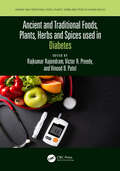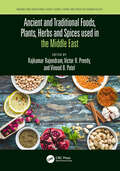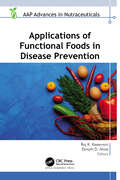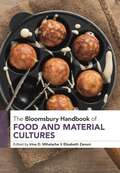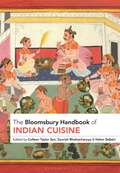- Table View
- List View
Ancient and Traditional Foods, Plants, Herbs and Spices used in Diabetes (Ancient and Traditional Foods, Plants, Herbs and Spices in Human Health)
The use of different foods, herbs, and spices to treat or prevent disease has been recorded for thousands of years. Egyptian papyrus, hieroglyphics and ancient texts from the Middle East have described the cultivation and preparations of herbs and botanicals to “cure the sick.” There are even older records from China and India. Some ancient scripts describe the use of medicinal plants which have never been seen within European cultures. Indeed, all ancient civilizations have pictorial records of different foods, herbs, and spices being used for medical purposes. However, there are fundamental issues pertaining to the scientific evidence for the use of these agents or their extracts in modern medicine. These issues are explored in Ancient and Traditional Foods, Plants, Herbs and Spices Used in Diabetes. Features · Investigates alternative healthcare paradigms that use traditional dietary foods, plant-derived materials, and extracts to treat diabetes · Describes scientific studies using modern day biomedical techniques · Provides information on diets, specific agents, extracts and resources. · Many chapters focus on plant-derived material, providing a historical background, uses, toxicity, and cautionary notes and summary points. There have been considerable advances in scientific techniques over the last few decades. These have been used to examine the composition and applications of traditional cures. Modern science has also seen the investigation of herbs, spices and botanicals beyond their traditional usage. Diabetes is one of the most common diseases worldwide, with over 400 million people with the illness. With chapter contributions by an international panel of contributors, this book is useful for researchers in the area of functional foods. Diabetologists, nutritionists, endocrinologists, healthcare workers, and pharmacologists will also find this book extremely valuable.
Ancient and Traditional Foods, Plants, Herbs and Spices used in the Middle East (Ancient and Traditional Foods, Plants, Herbs and Spices in Human Health)
The use of different foods, herbs, and spices to treat or prevent disease has been recorded for thousands of years. Egyptian papyrus, hieroglyphics and ancient texts from the Middle East have described the cultivation and preparations of herbs and botanicals to “cure the sick.” There are even older records from China and India. Some ancient scripts describe the use of medicinal plants which have never been seen within European cultures. Indeed, all ancient civilizations have pictorial records of different foods, herbs, and spices being used for medical purposes. However, there are fundamental questions and issues pertaining to the scientific evidence for the use of these agents or their extracts in modern medicine. These issues are explored in Ancient and Traditional Foods, Plants, Herbs and Spices used in the Middle East. Features · Describes uses and applications of plant-based materials from different countries of the Middle East. · Each chapter has unique cross references to foods, herbs, spices and botanicals · Bridges molecular biology, physiology and medical sciences · Coverage includes herbal medicines, supplements, lifestyle patterns, nutrition, and plant-based diets · Each chapter describes usage and applications of traditional foods and botanicals; historical background; toxicity; cautionary notes; and summary points There have been considerable advances in scientific techniques over the last few decades. These have been used to examine the composition and applications of traditional cures. Modern science has also seen the investigation of herbs, spices and botanicals beyond their traditional usage. Written by international experts, this is an essential read for food researchers, food scientists, and nutritionists, researchers and health professionals with an interest in the potential therapeutic value of Middle Eastern food components. The book will also be of relevance to physicians and pharmacologists.
Applications of Functional Foods in Disease Prevention (AAP Advances in Nutraceuticals)
Functional food sources are growing in popularity because they are exceptionally nutritious and provide amazing medical advantages. They can help ensure against infection, prevent supplement deficiency, and advance appropriate health development and improvement. With illustrative case studies, this new volume explores the many roles of functional foods in the prevention and management of various diseases, including diabetes, autism spectrum disorder, weight loss and obesity, microbial infections, ulcers and other gastrointestinal diseases, mental disorders and brain health, cardiac health and cardiovascular diseases, osteoporosis and bone health, and more.
Bell pepper (Cross-section) (Large Print)
This is a labelled image of a bell pepper in longitudinal cross section (cut through from top to bottom). There is a locator dot shown, which will be at the top left of the page when the image is the correct way up. The image of the bell pepper is in the middle of the page. At its centre is the fruits core covered by seeds. Around the core is a void, and around this, on the outside of the fruit, are its flesh and skin. At the top of the image is the peppers stem. The pepper is about ten centimetres long and although bright green when immature, can be be red, yellow or even orange when fully ripened.
Bell pepper (Cross-section) (UEB Contracted)
This is a labelled image of a bell pepper in longitudinal cross section (cut through from top to bottom). There is a locator dot shown, which will be at the top left of the page when the image is the correct way up. The image of the bell pepper is in the middle of the page. At its centre is the fruits core covered by seeds. Around the core is a void, and around this, on the outside of the fruit, are its flesh and skin. At the top of the image is the peppers stem. The pepper is about ten centimetres long and although bright green when immature, can be be red, yellow or even orange when fully ripened.
Bell pepper (Cross-section) (UEB Uncontracted)
This is a labelled image of a bell pepper in longitudinal cross section (cut through from top to bottom). There is a locator dot shown, which will be at the top left of the page when the image is the correct way up. The image of the bell pepper is in the middle of the page. At its centre is the fruits core covered by seeds. Around the core is a void, and around this, on the outside of the fruit, are its flesh and skin. At the top of the image is the peppers stem. The pepper is about ten centimetres long and although bright green when immature, can be be red, yellow or even orange when fully ripened.
The Bloomsbury Handbook of Food and Material Cultures
Cookbooks. Menus. Ingredients. Dishes. Pots. Kitchens. Markets. Museum exhibitions. These objects, representations, and environments are part of what the volume calls the material cultures of food. The book features leading scholars, professionals, and chefs who apply a material cultural perspective to consider two relatively unexplored questions: 1) What is the material culture of food? and 2) How are frameworks, concepts, and methods of material culture used in scholarly research and professional practice? This book acknowledges that materiality is historically and culturally specific (local), but also global, as food both transcends and collapses geographical and ideological borders. Contributors capture the malleability of food, its material environments and “stuff,” and its representations in media, museums, and marketing, while following food through cycles of production, circulation, and consumption. As many of the featured authors explore, food and its many material and immaterial manifestations not only reflect social issues, but also actively produce, preserve, and disrupt identities, communities, economic systems, and everyday social practices. The volume includes contributions from and interviews with a dynamic group of scholars, museum and information professionals, and chefs who represent diverse disciplines, such as communication studies, anthropology, history, American studies, folklore, and food studies.
The Bloomsbury Handbook of Indian Cuisine
This reference work covers the cuisine and foodways of India in all their diversity and complexity, including regions, personalities, street foods, communities and topics that have been often neglected. The book starts with an overview essay situating the Great Indian Table in relation to its geography, history and agriculture, followed by alphabetically organized entries. The entries, which are between 150 and 1,500 words long, combine facts with history, anecdotes, and legends. They are supplemented by longer entries on key topics such as regional cuisines, spice mixtures, food and medicine, rites of passages, cooking methods, rice, sweets, tea, drinks (alcoholic and soft) and the Indian diaspora. This comprehensive volume illuminates contemporary Indian cooking and cuisine in tradition and practice.
Burger (Large Print)
This is a picture of a burger seen from the side in the middle of the page. There is a locator dot shown, which will be at the top left of the page when the image is the correct way up. At the top of the picture is half of the burger bun. Going down the page from this is a slice of tomato, burger meat, a lettuce leaf, more burger meat, and lastly the other half of the bun. On the left hand side of the burger, near the bottom is a dollop of tomato ketchup dripping down.
Burger (UEB Contracted)
This is a picture of a burger seen from the side in the middle of the page. There is a locator dot shown, which will be at the top left of the page when the image is the correct way up. At the top of the picture is half of the burger bun. Going down the page from this is a slice of tomato, burger meat, a lettuce leaf, more burger meat, and lastly the other half of the bun. On the left hand side of the burger, near the bottom is a dollop of tomato ketchup dripping down.
Burger (UEB Uncontracted)
This is a picture of a burger seen from the side in the middle of the page. There is a locator dot shown, which will be at the top left of the page when the image is the correct way up. At the top of the picture is half of the burger bun. Going down the page from this is a slice of tomato, burger meat, a lettuce leaf, more burger meat, and lastly the other half of the bun. On the left hand side of the burger, near the bottom is a dollop of tomato ketchup dripping down.
Cacao fruit (Cross-section) (Large Print)
This is a labelled image of a cacao fruit in longitudinal cross section (cut through from top to bottom). This fruit is the source of cocoa beans, from which chocolate products are made. There is a locator dot shown, which will be at the top left of the page when the image is the correct way up. The image of the cacao fruit is in the middle of the page. At its centre is a cavity filled with white pulp and cocoa beans (seeds), which are also white and light brown, and only change to their familiar very dark brown colour after processing. The hard, leathery rind or skin is ridged and is up to three centimetres thick. The fruit is between fifteen and thirty centimetres long.
Cacao fruit (Cross-section) (UEB Contracted)
This is a labelled image of a cacao fruit in longitudinal cross section (cut through from top to bottom). This fruit is the source of cocoa beans, from which chocolate products are made. There is a locator dot shown, which will be at the top left of the page when the image is the correct way up. The image of the cacao fruit is in the middle of the page. At its centre is a cavity filled with white pulp and cocoa beans (seeds), which are also white and light brown, and only change to their familiar very dark brown colour after processing. The hard, leathery rind or skin is ridged and is up to three centimetres thick. The fruit is between fifteen and thirty centimetres long.
Cacao fruit (Cross-section) (UEB Uncontracted)
This is a labelled image of a cacao fruit in longitudinal cross section (cut through from top to bottom). This fruit is the source of cocoa beans, from which chocolate products are made. There is a locator dot shown, which will be at the top left of the page when the image is the correct way up. The image of the cacao fruit is in the middle of the page. At its centre is a cavity filled with white pulp and cocoa beans (seeds), which are also white and light brown, and only change to their familiar very dark brown colour after processing. The hard, leathery rind or skin is ridged and is up to three centimetres thick. The fruit is between fifteen and thirty centimetres long.
Cantaloupe Melon (Cross-section) (Large Print)
This is a labelled image of a cantaloupe melon shown in longitudinal cross section (cut through from top to bottom). There is a locator dot shown, which will be at the top left of the page when the image is the correct way up. The image of the cantaloupe melon fills the page. At its centre is a cavity filled with seeds. Surrounding this is the sweet and juicy flesh and thick rind-like skin of the fruit. The cantaloupe is about fifteen to twenty centimetres in length. Its skin is a dull beige grey colour but the flesh inside is a delicate pink orange.
Cantaloupe Melon (Cross-section) (UEB Contracted)
This is a labelled image of a cantaloupe melon shown in longitudinal cross section (cut through from top to bottom). There is a locator dot shown, which will be at the top left of the page when the image is the correct way up. The image of the cantaloupe melon fills the page. At its centre is a cavity filled with seeds. Surrounding this is the sweet and juicy flesh and thick rind-like skin of the fruit. The cantaloupe is about fifteen to twenty centimetres in length. Its skin is a dull beige grey colour but the flesh inside is a delicate pink orange.
Cantaloupe Melon (Cross-section) (UEB Uncontracted)
This is a labelled image of a cantaloupe melon shown in longitudinal cross section (cut through from top to bottom). There is a locator dot shown, which will be at the top left of the page when the image is the correct way up. The image of the cantaloupe melon fills the page. At its centre is a cavity filled with seeds. Surrounding this is the sweet and juicy flesh and thick rind-like skin of the fruit. The cantaloupe is about fifteen to twenty centimetres in length. Its skin is a dull beige grey colour but the flesh inside is a delicate pink orange.
Carrot (Large Print)
This image of a carrot fills the centre of the page. There is a locator dot shown, which will be at the top left of the page when the image is the correct way up. The carrot has a swollen taproot (main root), which is the part of the plant usually eaten, although the green leaves are edible and tasty. The root is sweet and crunchy. The carrots shoots and feathery leaves fill the top part of the page. They join the taproot in the centre of the page. The taproot of the carrot is usually coloured orange but some varieties are white or purple. It is fat at the top and tapers to a point at the bottom of the page. There are fine root hairs attached to the taproot through which the plant draws nutrition from the soil.
Carrot (UEB Contracted)
This image of a carrot fills the centre of the page. There is a locator dot shown, which will be at the top left of the page when the image is the correct way up. The carrot has a swollen taproot (main root), which is the part of the plant usually eaten, although the green leaves are edible and tasty. The root is sweet and crunchy. The carrots shoots and feathery leaves fill the top part of the page. They join the taproot in the centre of the page. The taproot of the carrot is usually coloured orange but some varieties are white or purple. It is fat at the top and tapers to a point at the bottom of the page. There are fine root hairs attached to the taproot through which the plant draws nutrition from the soil.
Carrot (UEB Uncontracted)
This image of a carrot fills the centre of the page. There is a locator dot shown, which will be at the top left of the page when the image is the correct way up. The carrot has a swollen taproot (main root), which is the part of the plant usually eaten, although the green leaves are edible and tasty. The root is sweet and crunchy. The carrots shoots and feathery leaves fill the top part of the page. They join the taproot in the centre of the page. The taproot of the carrot is usually coloured orange but some varieties are white or purple. It is fat at the top and tapers to a point at the bottom of the page. There are fine root hairs attached to the taproot through which the plant draws nutrition from the soil.
Cauliflower (Large Print)
This image of a cauliflower fills the centre of the page. There is a locator dot shown, which will be at the top left of the page when the image is the correct way up. This vegetable is in fact a highly modified flower. It is a member of the Brassicaceae family, which includes cabbage, sprouts, broccoli and kale. The head (or curd) of the cauliflower is at the top of the image; it has a lumpy texture and is a creamy white in colour. Down the page are the thick green leaves with their thick, lighter-coloured veins spreading out from the cauliflower's stalk at the bottom of the image.
Cauliflower (UEB Contracted)
This image of a cauliflower fills the centre of the page. There is a locator dot shown, which will be at the top left of the page when the image is the correct way up. This vegetable is in fact a highly modified flower. It is a member of the Brassicaceae family, which includes cabbage, sprouts, broccoli and kale. The head (or curd) of the cauliflower is at the top of the image; it has a lumpy texture and is a creamy white in colour. Down the page are the thick green leaves with their thick, lighter-coloured veins spreading out from the cauliflower's stalk at the bottom of the image.
Cauliflower (UEB Uncontracted)
This image of a cauliflower fills the centre of the page. There is a locator dot shown, which will be at the top left of the page when the image is the correct way up. This vegetable is in fact a highly modified flower. It is a member of the Brassicaceae family, which includes cabbage, sprouts, broccoli and kale. The head (or curd) of the cauliflower is at the top of the image; it has a lumpy texture and is a creamy white in colour. Down the page are the thick green leaves with their thick, lighter-coloured veins spreading out from the cauliflower's stalk at the bottom of the image.
Cherries (Large Print)
This page shows an image of two cherries joined by their stalks, and a leaf. They are slightly larger than life-size. There is a locator dot shown, which will be at the top left of the page when the image is the correct way up.Just to the right of centre you can find the leaf with its pattern of veins. To the left of this, the two stalks curve down to the fat, sweet red cherries nearer the bottom of the page.
Cherries (UEB Contracted)
This page shows an image of two cherries joined by their stalks, and a leaf. They are slightly larger than life-size. There is a locator dot shown, which will be at the top left of the page when the image is the correct way up.Just to the right of centre you can find the leaf with its pattern of veins. To the left of this, the two stalks curve down to the fat, sweet red cherries nearer the bottom of the page.
